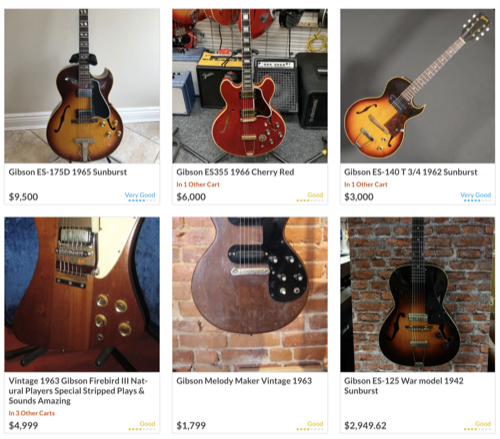Joe Szuecs, Founder of the Maker Music Festival

Cool Tools Show 288: Joe Szuecs
Our guest this week is Joe Szuecs, the founder of the Maker Music Festival. Joe is also the president of Chimera Arts maker space located in Sonoma County, California. Joe is a software developer, artist, musician and avid home cook. You can find Maker Music Festival on YouTube, and on Instagram @makermusicfest and on Twitter @makerfestival.
Subscribe to the Cool Tools Show on iTunes | RSS | Transcript | See all the Cool Tools Show posts on a single page
Show notes:

Sonic Pi: code-based music creation and performance tool
One of the things I do is I’m a musician, I’m a guitar player, and I gig here and there locally and make music. Sonic Pi combines two things — me as a software developer and me as a musician. So now I’ve got this Ruby-based coding language that I can make music with. I wrote my own drum machine where I can enter in patterns. And so now I can use that as a backing. And then as a programmer, flowcharty kind of guy, there are these rules for chord progressions in music, and so I was able to sit there and write new kinds of songs. I wrote this application in Sonic Pi to just generate chord progressions, and then it would just play them. And I would just listen to them, and then I would say, “Ah, I kind of liked that passage.” So now you can pause it and then see what it did. And then I could take that and go from there as to actually compose music that I would record later. Also, it deals with samples really well. The Smithsonian released a whole library of samples. And it’s just got all this crazy old musics all from movies and things like that. And I used that to kind of play around with layering these sort of sample pieces over these chord progressions and so it’s a lot of fun to play with to create these sort of things.

Large format Chinese Laser Cutters on AliExpress — 100 watt, Ruida control, LightBurn software
In most Makerspaces laser cutters are kind of expensive, especially for high powered ones. But we bought this Chinese one a while back, and it’s big, it’s three foot by four feet. It does not have a model number or name. It’s AliExpress. You got to always do some research to find them. But the ones you want are ones that have a Ruida controller because then it’ll run LightBurn, which is the controlling software. We’ve run ours for at least five years. And we’ve got members who don’t know what they’re doing running them, and so it’s held up today. I think it’s just that they’re worth a serious look at if you’re a Makerspace or even for a personal user. And the ones that we have are 100 watt models, so they’re quite large for three foot by four foot cut area, but they’re also very fast. There are also smaller Chinese cutters called “K40″s. I think they’re like 500 bucks. So if you want to get into laser cutting and play around, go for it. Just do your research. There’s plenty of YouTube stuff. They change all the time, so that’s why it’s hard to say, “Buy this model.”

Inkscape
Inkscape is what I use to generate patterns. It’s free, which is nice, so you get into it and play around with it. It’s an Illustrator equivalent. The nice thing about it, one, it’s free. Secondly, I prefer how the interface works. I find it much easier to use, and it’s fast, much faster. It doesn’t have all the overhead of Illustrator. So I think if what you’re doing is mostly laser cutting and things like that, it’s a great way to go. And then for instance, with the Maker Music Festival, that whole interface, those are SVG files, all those buildings, right? Because SVG files can be manipulated by JavaScript. So basically, I was doing a number of projects before this where I was using JPEGs and overlaying things. And oh God, you have to tell them where to go and everything. Whereas with the SVG files, they’re Java scriptable. You can tell it that if they get clicked, something’s going to happen here, you can manipulate them and change them. So I used Inkscape to design that whole interface and do all of that.

Old Gibson “player” guitars
Years ago, I bought an old Gibson 1934 L4. It’s old, and so it’s pretty cool. The thing was that with mine, it was that the the sun had faded out the serial number. And so it knocked its value down quite a bit because now they can’t trace it. The other thing about the ’34 L4 was that it’s a working man’s guitar, nothing fancy, not very collectible. But it’s a great guitar, the finish, all checked and obvious sweat stained and the whole sort thing. They sound great. Get one that’s kind of beat up. Not cracked, make sure it’s in decent shape, but very playable. And then you can get it for about a $1000. And it’s just a cool looking guitar. It sounds great, and you don’t worry about it because it’s all beat up already.
About Maker Music Festival:

Recently, we had like 20 hours of live streaming, as well as a big push to get the site up with almost 300 projects on there. And that’s still there, and that’s still living. And so now we’re working on keeping that going. So monthly live events, as well as working on collaboration, collaborative things. I had a meeting this morning with Cynthia from Jack Trip, which is a live synchronization tool out of Stanford’s CCRMA. And so anyway, so we’re looking at collaboration and things like that. So there’s a bunch of stuff to do with the Makers Music Festival.









